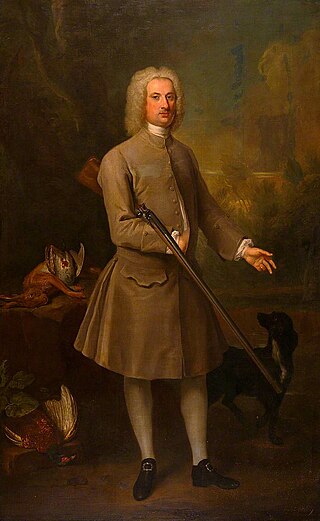Related Research Articles

Dumfriesshire was a county constituency represented in the House of Commons of Great Britain from 1708 to 1801 and in the House of Commons of the Parliament of the United Kingdom from 1801 until 2005. It was known as Dumfries from 1950.
Sir John Barker, 4th Baronet was an English baronet and Tory politician.

Sir Charles Blois, 1st Baronet, of Grundisburgh Hall and Cockfield Hall, Yoxford, Suffolk, was a British Tory politician who sat in the English House of Commons and the House of Commons of Great Britain between 1695 and 1709.

James Johnstone, 3rd Earl of Annandale and Hartfell and 2nd Marquess of Annandale (c.1687–1730) was a Scottish art collector and politician who sat in the British House of Commons briefly in 1708 before being disqualified as eldest son of a Scottish peer.
Sir William Villiers, 3rd Baronet was an English politician from the Villiers family.
Sir James Abercrombie, 1st Baronet, of Edinburgh, was a British Army officer and Scottish Whig politician who sat in the House of Commons of Great Britain in 1710.
Sir Alexander Murray, 3rd Baronet was a Scottish baronet and politician. He was a son of Sir David Murray (1659–1729) and his first wife, Anne Bruce.

Ralph Bell of Thirsk, North Yorkshire was an English country gentleman and politician who was a member of the House of Commons from 1710 to 1717.
Sir William Johnstone, 2nd Baronet of Sciennes and Westerhall was a Scottish landowner and politician who sat in the Parliament of Scotland from 1698 to 1707 and in the British House of Commons between 1707 and 1722.
Sir James Johnstone, 4th Baronet ) was a Scottish officer in the British Army and then a politician. He sat in the House of Commons of Great Britain for all but one of the years 1784 to 1794.
Sir Gilbert Eliott, 3rd Baronet, of Stobs was a Scottish Whig politician who sat in the British House of Commons between 1708 and 1727. He was outlawed after killing his opponent in an after-dinner argument and fight, but was subsequently pardoned.

Colonel John Stewart was a Scottish professional soldier, first in the Scottish Army and then in the British Army. He served with the army in Scotland, France and Flanders, and held a seat in the House of Commons of Great Britain from 1708 to 1715.
Sir Thomas Barnardiston, 2nd Baronet was an English nobleman and Whig politician.
Sir Alexander Reid, 2nd Baronet was a Scottish laird and politician from Aberdeenshire. He sat in the House of Commons of Great Britain from 1710 to 1713.
Charles Oliphant was a Scottish physician and politician who sat in the House of Commons from 1710 to 1719. He built his medical career in Edinburgh, but moved to London in 1708. He became physician to the Prince of Wales.
The Honourable James Campbell of Burnbank and Boquhan was a Scottish nobleman of Clan Campbell. He was an officer of the Royal Scots Army and then the British Army, and a politician who sat in the Parliament of Scotland from 1699 to 1702 and as a Whig in the British House of Commons from 1708 to 1710.
John Pringle, Lord Haining was a Scottish lawyer, politician, and judge. His ownership of a large estate near Selkirk secured him a seat in the Parliament of Scotland from 1702 until the Act of Union in 1707, and then in the House of Commons of Great Britain from 1707 until he became a Lord of Session in 1729.

Hartrigge House or Stewartfield House was a country house in Jedburgh in the Scottish Borders. Its first owner was in 1614 and it was rebuilt in 1854. It was the home to the Lord Chancellor, John Campbell, 1st Baron Campbell. It was demolished in the 1950s. Some listed outbuildings and lodges still exist.
Henry Pelham was an English Member of Parliament. A younger son of Sir John Pelham, 3rd Baronet, he was returned for two Parliamentary constituencies in Sussex, where the family held considerable influence, for most of the time between 1690 and 1702. Appointed to the sinecure office of Clerk of the Pells in 1698, Pelham was a reliable Whig and Court-supporting placeman.
References
- 1 2 Wilkinson, David (2002). D. Hayton; E. Cruickshanks; S. Handley (eds.). "JOHNSTONE, William (d. 1727), of Sciennes (Sheenes), Edinburgh, and Westerhall (Westraw), Dumfries". The History of Parliament: the House of Commons 1690-1715. Boydell and Brewer. Retrieved 2 July 2014.
- 1 2 3 4 Wilkinson, David (2002). D. Hayton; E. Cruickshanks; S. Handley (eds.). "JOHNSTONE, Sir John, 1st Bt. (d. 1711), of Westerhall (Westraw), Dumfries". The History of Parliament: the House of Commons 1690-1715. Boydell and Brewer. Retrieved 4 July 2014.